| Spotlight
Of Forgotten Comics and Cartoons
Yamin Tauseef Jahangir
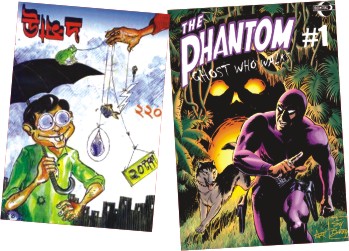 BACK in the times when I was a kid I used to drool in broad daylight over my comic super heroes and wish for a 'bat-mobile' or all the cool gadgets that one can have to fight against crimes. I remember talking about Tintin and Asterix with my friends and even argued over being as strong as Obelix. I was indeed a comic addict and often used to drag my parents to the bookstore and convince them to buy me enough so that I could keep myself busy for the weekends. I have always been a huge fan of Archies and since I had the same eating habits like Jughead, I even went on searching for a crown that would make me and Jughead have some resemblance! BACK in the times when I was a kid I used to drool in broad daylight over my comic super heroes and wish for a 'bat-mobile' or all the cool gadgets that one can have to fight against crimes. I remember talking about Tintin and Asterix with my friends and even argued over being as strong as Obelix. I was indeed a comic addict and often used to drag my parents to the bookstore and convince them to buy me enough so that I could keep myself busy for the weekends. I have always been a huge fan of Archies and since I had the same eating habits like Jughead, I even went on searching for a crown that would make me and Jughead have some resemblance!
Being an avid reader of several comic strips have always made me learn English and Bangla right from my early school years and this in a way has helped me to have a good grasp over the languages. Comics and cartoons in a way allow us to idolise certain characters when we are young and we learn certain things about life. If you take Captain Planet as an example, you will see that in every episode, they do show how we can recycle objects that we use in our everyday lives and that too in a better way while keeping the environment clean. Comics on the other hand create a reading habit and as they are full of colours on glossy papers, which does attract our attention and in a way influence us to read more. It also relates the words with the characters making it more life-like. I remember the times when I used to compare my cartoon or comic characters with my friends and even behaved like them. Children nowadays have lost the touch with comics and are more involved in playing video games or handling cool gadgets. It is not surprising to see that many are now even using cellular phones to gossip for long hours from a very early age and parents in many cases support this. I was lucky to have spent time with some amazing friends in my childhood and we did have a tree-house that we called our 'hide out', and it was a regular meet up place for the whole gang and talk about our comic collection or playing the characters of our superheroes.
Children are now exposed to better technology so it is almost obvious that they will be fast learners. But it also is the responsibility of the parents to make sure that they remain as children and are not imitating the elders in the process of their growing up. When I gave my O'Level Examinations I across a reading passage that talked about how Popeye the cartoon has helped a lot of school toddlers to improve their diet. It was stated in the passage that a daily show of Popeye used to be aired for half an hour and children saw how spinach made their favourite hero to be strong to fight against the mighty Bluto. This made them have spinach on a regular basis and apart from studies it was healthy recreation as well for these children. The cartoons have changed a lot over the years and sadly enough not all of them are educative but rather are only for enjoyment.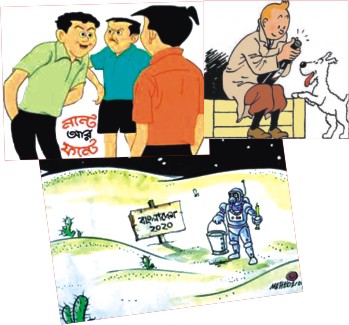
If we talk about comics, then Tintin and The Phantom has been my favourite of all. But now, I see the new generation kids hardly know them and they really do not want to spend time on reading. The process of growing up has completely changed from our times and now no one actually cares to consider this. I managed to read a lot of Bangla comics as well, and I really liked 'Nontey Fontey', where the stories used to revolve around a boarding school and how the two friends did all the mischief one can ever think of. But then again it also used to reflect how these characters helped out their beloved teacher whenever there was a crisis. So the comic did have a message to convey to the society that I believe should be considered. If you talk about 'Unmad', then I'm sure you'll agree with me that it created a revolution in terms of comics in Bangladesh. It started small, but later it earned it popularity as being the funniest the most satirical comic ever in our country. Although at times it used certain dialects but even then it remained as an interesting read and through the sarcasm and criticism, the Unmad character has tried to deliver the message to us, which was always for the betterment of the society itself. It never confined itself in specific subjects but spoke about education system, politics, tourism, environment and through laughter it allowed the readers to get a clear picture of the current scenario.
The very essence of comics is fading away from the up coming generation. Is it for ignorance or the lack of support that will always remain a question, but comic do play a significant role if you indulge yourself to be a part of that world. Parents should make time from their busy chores and take the child to a good bookstore and introduce him to the world of comics. We need to make our children grow the
sense of responsibility, let it be by making them like a superhero, or a cartoon character, it really can instill some good qualities in the child and help them to understand the difference between the rights and the wrongs of life.
Evolving into a Comic Fan!
Sumaiya Ahsan Bushra
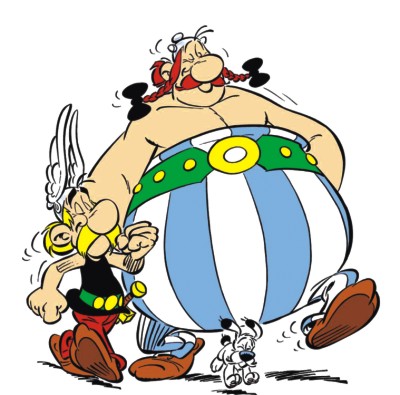 LIKE every other kid of my generation, reading comic books was my favourite pastime. In fact, I actually had phases in my life during which I was engrossed in reading different kinds of comic books. It had all started with Batman and Superman - my all time favourite superheroes! I watched my brother read them when I was five years old and as soon as I was eight I began collecting them like an obsessed maniac. The idea of these two superheroes saving the world and the fascinating theme of their love life always intrigued me. LIKE every other kid of my generation, reading comic books was my favourite pastime. In fact, I actually had phases in my life during which I was engrossed in reading different kinds of comic books. It had all started with Batman and Superman - my all time favourite superheroes! I watched my brother read them when I was five years old and as soon as I was eight I began collecting them like an obsessed maniac. The idea of these two superheroes saving the world and the fascinating theme of their love life always intrigued me.
Soon after (when I was a little older and being the queen of mischief that I am) I learnt how to “tune” channels on the television without using a proper satellite connection. That's when I stumbled upon the Indian hero “Shaktimaan”, on these illegally received channels, and started going “bonkers” over him. There came a point when my mom took me to buy my schoolbooks and the only thing I wanted to buy was a “Shaktimaan” comic book which I had spotted at an almost impossibly noticeable corner of the book store.
However, I soon evolved from my queer fixation over a tacky Indian superhero and moved onto something more tasteful which in my case was the comic book Asterix. Asterix was one of those rare comic books which my neighbour and I only read. It wasn't that popular back in the day and was rarely available. However, I was lucky enough to have been the sole inheritor of my brother's treasure trove of Asterix comics (which he took great pains to collect) and hence I had the luxury of having them available for reading despite their scarcity. 
Now, we have all read Asterix at one point in our lives. However, for those who had the Rip Van Winkle syndrome and slept through the Asterix age this little description should come in handy. Astrix is a French comic book based on a small village Armorica of Gaul. In the comic, all of Gaul has been occupied by the Romans except for that one village inhabited by indomitable Gauls who gallantly hold out against the Roman occupation of Julius Caesar. The protagonist of the comic, Asterix is a supremely cunning and mind bogglingly intelligent maverick who can beat up a good hundred roman soldiers in one go with the aid of a powerful magic portion - a unique invention by the wise and sometimes hot headed “druid” of the village, Getafix. To assist Asterix in his adventures through the village and all over the world is his best friend Obelix an obese and rather unintelligent man whose strength and size cannot be underestimated as he was a victim who fell into the druid's cauldron of magic potion when he was a baby and gained permanent superhuman strength. Obelix likes nothing better than eating wild boars and gulping down mugs of beer to facilitate his obesity - a fact highlighted throughout each comic and at the end of almost every one of their adventures.
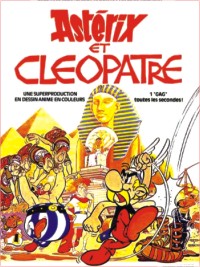 Other characters in the comic include the village chief Vitalstatistix and his wife Impedimenta, Cacofonix the bard, Geriatrix the oldest man in the village and Unhygienix the fishmonger. Cacofonix's off tune voice meshed with the sound of his equally mistuned playing of the lyre repels everyone rather than bring them together in “harmony”. Chief Vitalstatistix is another unique character who is majestic, hot-tempered and brave with only one fear which is that the sky might fall on his head tomorrow. He has an even bizarre way of containing his fear by proclaiming that “Tomorrow never comes”! Impedimenta is the chief's nagging wife who is arguably the only one in the village against whom the chief has no say. Lastly, Unhygienix, the fishmonger, is another eccentric character who prefers to transport fishes all the way from Lutetia instead of using his boat to fish from the nearby sea. These peculiar characters mixed with the fable of superhuman strength garnering magic potion and a tampering of historical facts (where the Gauls hold out against Julius Caesar much to his dismay and apparent mockery) coupled with a fresh blend of French humour make the comic an absolute ball to read. Other characters in the comic include the village chief Vitalstatistix and his wife Impedimenta, Cacofonix the bard, Geriatrix the oldest man in the village and Unhygienix the fishmonger. Cacofonix's off tune voice meshed with the sound of his equally mistuned playing of the lyre repels everyone rather than bring them together in “harmony”. Chief Vitalstatistix is another unique character who is majestic, hot-tempered and brave with only one fear which is that the sky might fall on his head tomorrow. He has an even bizarre way of containing his fear by proclaiming that “Tomorrow never comes”! Impedimenta is the chief's nagging wife who is arguably the only one in the village against whom the chief has no say. Lastly, Unhygienix, the fishmonger, is another eccentric character who prefers to transport fishes all the way from Lutetia instead of using his boat to fish from the nearby sea. These peculiar characters mixed with the fable of superhuman strength garnering magic potion and a tampering of historical facts (where the Gauls hold out against Julius Caesar much to his dismay and apparent mockery) coupled with a fresh blend of French humour make the comic an absolute ball to read.
I have read almost every Asterix comic published and each was entertaining and interesting in its own way. However “Asterix and Cleopatra” is my favourite and believe me when I say this as I have read this particular issue eight times! Being an introvert throughout a majority of my childhood, I was always caught in the corner reading comics. Reading Astrix was my gateway to escape from the large piles of homework and the insane memorisation of chemical formulae. It was always a pleasure to read Asterix in class while the teacher was busy explaining Darwin's theory of evolution; it was even more exciting when my mom demanded that I do my homework in front of her, while all I cared about was “angle setting” my Asterix in between my math book. 
Growing up reading comics like Asterix was a treat and it was a phase of my life which I cherished. It was a time that I know I can never have again. So I urge all the young people out there to indulge in reading comic books and enjoying their childhood. These are the moments that are rare and once they are gone you can never have them back because life eventually engulfs one and sucks out the energy like a deadly parasite. So why not have a “Comic” beginning to a “Tragic” ending. What do you say?
The Rise of
'Superheroes'
By Rajiv Ashrafi
 SUPERHEROES have been around even longer than our grandparents. Maybe even their grandparents. Everyone now knows (and loves) 'underwear perverts' as Warren Ellis likes to call them with prime examples of Spiderman, Batman and the most notorious underwear offender of them all: Superman. But did you know these fictional 'perverts' have gone through a lot since their inception? No, I'm not referring to their convoluted storylines, but their impact on the real world and vice versa. SUPERHEROES have been around even longer than our grandparents. Maybe even their grandparents. Everyone now knows (and loves) 'underwear perverts' as Warren Ellis likes to call them with prime examples of Spiderman, Batman and the most notorious underwear offender of them all: Superman. But did you know these fictional 'perverts' have gone through a lot since their inception? No, I'm not referring to their convoluted storylines, but their impact on the real world and vice versa.
The rise of wearing-your-underwear-on-the-outside can be blamed on the creation of Superman back in 1938. His debut in Action Comics started the whole superhero craze that sparked the Golden Age of comics that lasted till the mid 1950s. During that time, superheroes took part in simpleton stories that even a mentally handicapped serial killer could understand; in fact, they were cheap and disposable escapist entertainment.
World War II had a role to play in the prominence of superheroes, as soldiers turned to stories of good triumphing over evil. This gave birth to other underwear offenders including Wonder Woman, Batman, Captain Marvel and the most topical of them all Captain America. They were all seen fighting the Axis, battling Nazis and defeating Hitler with their superpowers that amazed dimwits and made evildoers do things in their pants anyone would be ashamed of.
Those simple stories gave way to sophisticated characterisations and dynamic stories as the '50s came to a close. Superheroes were given makeovers and retooled for the can-do optimism of the '60s, thanks to legends such as Stan Lee, Jack Kirby and Steve Ditko, just to name a few. The Silver Age of superheroes began with The Flash (who, thankfully, wears his undergarments on the inside) who started the new generation of self-doubting, flawed characters. This was followed by Marvel Comics' Fantastic Four and Spiderman, who are loved for the fact that they could be your neighbors, or maybe even you.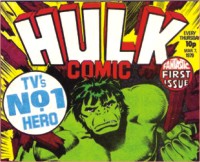
It is during this time that Marvel began its rise by creating similar psychologically troubled characters such as Iron Man (drinks, anyone?), Thor (daddy issues, anyone?), Daredevil (daddy issues, again), Hulk (SMASH!!!) and the X-Men. DC hit back by retooling their older characters, including Green Lantern, Atom and Hawkman.
While these characters embraced the '60s optimism and rolled around in wads of cash, the world had become a darker place. So did the comics. Characters weren't dying left and right like they do now, but the granddaddy of all character deaths could be found in Spiderman when his girlfriend Gwen Stacy had had her neck snapped, the crack of which marked the era of tomfoolery and innocence.
This gave rise to the Bronze Age that started in the '70s and lasted till the mid '80s. The men of action were given darker plot elements and more mature storylines. It was also during this time that writers started handling real-life issues alongside gods, aliens, magic and other gibberish they could come up with while high on a certain white stuff. Drug use was featured in Spiderman and Green Lantern; it was portrayed in a negative light. They also handled racial prejudice and social inequity, offering contemporary social commentary. The X-Men became wildly popular for this reason. Minority superheroes also came to the spotlight, though they still had some racial stereotypes attached to them. Notables include Luke Cage and Storm in Marvel; DC was a bit braver, replacing Hal Jordan with John Stewart as the Green Lantern.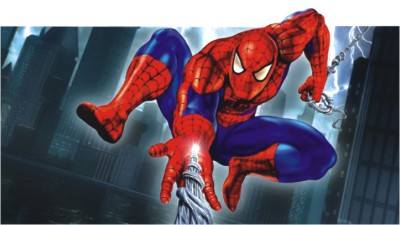
The heroes weren't content fighting each other, though, as this era gave birth to some epic crossovers, the likes of which are not seen these days. Superman vs. Spiderman was the first big crossover, teaming the Son of Krypton with a New York kid. This was followed by Hulk vs. Batman and the best of them all The Avengers vs. Justice League of America.
The world was becoming an ever darker place, and the comics had to catch up. The Modern Age of comics brought about even darker and more psychologically complex characters. This started with two seminal comic books Frank Miller's magnum opus Batman: The Dark Knight Returns and Alan Moore's brilliant Watchmen.
 These two works started a move towards emotional realism, where the perverts had a deep psychological impulse to destroy criminals, and weren't some cardboard cutout characters who were on a quest to destroy evil. This move gave rise to antiheroes and the notion of superheroes changed as well. Garth Ennis' Preacher, Neil Gaiman's Sandman and Alan Moore's Swamp Thing are a couple of notables. Current superheroes changed as well: Galactus became a force of nature rather than a villain and Magneto became a sympathetic man who was fighting for the oppressed. These two works started a move towards emotional realism, where the perverts had a deep psychological impulse to destroy criminals, and weren't some cardboard cutout characters who were on a quest to destroy evil. This move gave rise to antiheroes and the notion of superheroes changed as well. Garth Ennis' Preacher, Neil Gaiman's Sandman and Alan Moore's Swamp Thing are a couple of notables. Current superheroes changed as well: Galactus became a force of nature rather than a villain and Magneto became a sympathetic man who was fighting for the oppressed.
This brings us to the current state of the union. Superheroes have infiltrated popular culture, showing off their undergarments on television, film, videogames and what not. Superman went on to have a career on television in Smallville; Spiderman broke box office records; Hulk went emo in Ang Lee's film; Batman redefined emo in his last two films; and finally Iron Man recreated the definition of cool in his movies.
All the while, little kids were creating groups of superheroes in the Ultimate Alliance and X-Men games; sacks of money were made selling action figures; and finally, Marvel was acquired by Disney.
The future looks good for us underwear lovers as well. Comics are now going digital thanks to the iPad and  file-sharing websites. Next year will see Marvel heroes battling Capcom heroes once again and Batman taking on Joker & Friends in Arkham Asylum's sequel. Movie fans are foaming at the mouth for The Avengers team-up, Thor, Green Lantern and the second Batman sequel. And don't forget the Spiderman reboot! file-sharing websites. Next year will see Marvel heroes battling Capcom heroes once again and Batman taking on Joker & Friends in Arkham Asylum's sequel. Movie fans are foaming at the mouth for The Avengers team-up, Thor, Green Lantern and the second Batman sequel. And don't forget the Spiderman reboot!
It's a great time to be an underwear pervert.
(The writer is a graduate of English, North South University)
When Archie and his Crew was All That!
Sameeha Suraiya
SOMETIMES, the teacher would catch you take a sneak peek under the table in the middle of a math class. Sometimes the thin paperback would find its way inside a Bangla grammar book, cleverly tucked in. Eyes would be riveted upon the wildly enticing colours as all imagination was let loose. The characters of Archie Andrews and his unforgettable friends would spring up right out of the pages and find their places in that fat boy sitting at the very end of a classroom or that charming do-gooder, who has the boys glued, or the boy next door, an all-star athlete who helps out his friends no matter what. 
Archie Comics was a slice of the Western world that somehow found a dear place in every Bangladeshi youngster's heart and it still continues to attract readers, some of who have carried on reading the series since their pre-teen or teen years. Judging from the dusty piles at Nilkhet and the brand new, glossy paperbacks firmly sitting on the shelves of almost every bookshop in Dhaka, Archie Comics is definitely not a thing of the past or a token of the West! Sure we learnt expressions like 'egad' or 'sheesh' but there was the magnetic quality of its characters that was oddly comforting, as though there did exist a bit of Veronica Lodge or a bit of jughead Jones in each one of us. And of course, no kid is too young to understand subtle humour and word play, which the best Archie stories have.
“America's newest boyfriend”, Archiebald Andrews also opened up this whole new world to Bangladeshi kids where a girl and a boy could be something else other than enemies. Seeing stars or getting hearts broken were slowly getting to be recognised and experienced as suddenly Betty Coopers or Reggie Mantles were discovered in classrooms and of course, the rest is history! Parents were not found forbidding reading Archie Comics at home, even though watching Hollywood movies were closely monitored, sometimes censored by the press of a forward button. Perhaps it was the youthful innocence of each of the characters that made them blind or perhaps it was their own once-upon-a-time obsession with Riverdale High and its students! 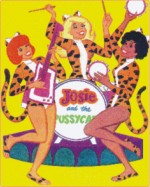
To add a bit of background, Archie Comics before finding its name and popularity, started out as a venture of MLJ magazines in 1939. Writer Vic Bloom and artist Bob Montana published Archie Andrew's first adventure in the comic series titled Pep Comics, which featured The Shield, America's first patriotic comic book hero. Finding instant popularity, Archie, however, became the dominant feature and soon MLJ magazines changed its name to Archie Comics Publications. Joining into the bandwagon later in the early 1960s were the series Josie and the Pussycats and Sabrina the Teenage Witch. They sometimes made their appearances in the crossover issues with the main Archie characters. After the deluge of men in superhero costumes, finally seeing beautiful girls not going moony-eyed every time the hero pops up, but instead wearing the boots and taking control definitely came like a breath of fresh air.
Archie Comics have survived through quite a few generations. Its copies may lie in some forgotten corner of the shelf but its characters are all but timeless. There are still more surprises to come in its upcoming series, so rest assured, all is not over yet for the Riverdale fans!
Tintin, A Great Literature
Sarah Z H
 TINTIN, as the first real comic undermines the distinction between high and low art, suggesting that such categorizations are arbitrary at best. Thus, Tintin's creator, Hergé (Georges Remi) can and should be considered a forerunner to artists such as Andy Warhol and Salvador Dalí, for Tintin is an aesthetic prototype for the 20th century, serving as an amalgamation of various artistic forms: painting, literature, dime novels, serial works, burlesque shows, and caricatures, which have all been shaken and stirred for mass consumption. Tintin's face, round as an O with two pinpricks for eyes, is what Hergé himself described as 'the degree zero of typeage'a typographic vanishing point. Tintin is also the degree zero of personage. He has no past, no sexual identity, no complexities . . . he is a writer who does not write. As Tintin could tell you, if there are secret operations going on in this degree-zero zone of writing, then these can only be approached by overlaying, reading across, reading through. His backstory is a mere sketch. His inner passions and desires beyond a boy-scoutish passion for 'doing good' and hiking about in the open air, and his love for his dog are mysteries to us. This creates imaginative space in which all manner of flavorsome fantasy on the reader can flourish. All said, I am not a fan of Tintin but the fact that it aspires and succeds to be a great literature is supported by the utilizations of varied disciplines as pychoanalysis, post-structuralism and New Criticism, and even post-Marxist models of economic or cultural dynamicsall to pick apart the enigma that is Hergé, that is Tintin. TINTIN, as the first real comic undermines the distinction between high and low art, suggesting that such categorizations are arbitrary at best. Thus, Tintin's creator, Hergé (Georges Remi) can and should be considered a forerunner to artists such as Andy Warhol and Salvador Dalí, for Tintin is an aesthetic prototype for the 20th century, serving as an amalgamation of various artistic forms: painting, literature, dime novels, serial works, burlesque shows, and caricatures, which have all been shaken and stirred for mass consumption. Tintin's face, round as an O with two pinpricks for eyes, is what Hergé himself described as 'the degree zero of typeage'a typographic vanishing point. Tintin is also the degree zero of personage. He has no past, no sexual identity, no complexities . . . he is a writer who does not write. As Tintin could tell you, if there are secret operations going on in this degree-zero zone of writing, then these can only be approached by overlaying, reading across, reading through. His backstory is a mere sketch. His inner passions and desires beyond a boy-scoutish passion for 'doing good' and hiking about in the open air, and his love for his dog are mysteries to us. This creates imaginative space in which all manner of flavorsome fantasy on the reader can flourish. All said, I am not a fan of Tintin but the fact that it aspires and succeds to be a great literature is supported by the utilizations of varied disciplines as pychoanalysis, post-structuralism and New Criticism, and even post-Marxist models of economic or cultural dynamicsall to pick apart the enigma that is Hergé, that is Tintin.
Comics and Memories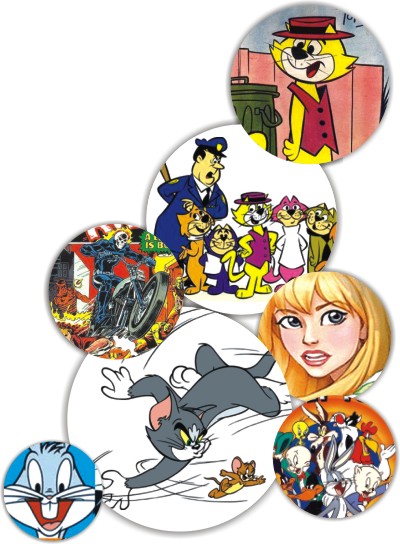
Shahnoor Wahid
Apile of comics - Archies, Tintin, Asterix, Top Cat - collect dust in one corner of my room - mutely protesting my not giving them a proper treatment. They are there for many years now. I try my best to avoid looking at them as they bring back memories. Memories that make me nostalgic, lonesome. On a rainy day, when I have no work to do, on an impulse I pick up one of them. I wipe specks of dust off it and then slowly caress the cover - by now substantially faded - with many names scribbled on it. Names I heard so many times - years ago. I could even associate some faces with some of those names. Where are they? I felt a little empty inside. I picked up another one - Top Cat - and remembered buying it from the UAE Market at Banani. I smiled as I flipped through the pages - some torn here and there. I remembered how I had to go again and again to Zeenat Book Store at New Market all the way from Uttara to buy the latest copy of Tintin.
I remembered how I had retrieved those comics from under the bed of every room, from the top of the cupboards, top of the refrigerator, from the bathroom, window ledge, garage shelf, trunk of my car and so on. Hundreds of them. I dusted them with great care one by one. Then stacked them in one corner of my room on a stool. I just cannot throw them away. I live with them as they make me feel as if my son would barge in anytime and look for one of them. I know it’s only a dream. I know he cannot do that as he lives far away from me, in another country across the oceans. I know he does not read comics anymore, but to me he is still the child who read comics and giggled.
I begin dusting again.
|

